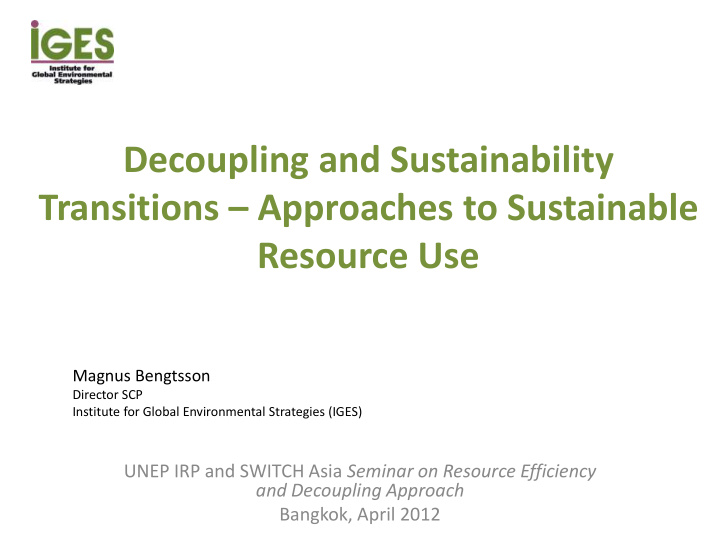



Decoupling and Sustainability Transitions – Approaches to Sustainable Resource Use Magnus Bengtsson Director SCP Institute for Global Environmental Strategies (IGES) UNEP IRP and SWITCH Asia Seminar on Resource Efficiency and Decoupling Approach Bangkok, April 2012
No Sign of Decoupling – The Example of Metals Global trends in primary metal extraction, 1990-2007 After almost 20 years of international policy discussions on sustainability: a negative decoupling for four out of five base metals Rio Conference Johannesburg Source: Jackson 2009 Agenda 21 Plan of Implementation
These two kinds of decoupling are the most important ones but still not much discussed They don’t even have names! Source: UNEP 2011b • Decoupling is an ambition but still only a theoretical concept • No one knows whether sufficient decoupling can actually be achieved within the required time-frame The lock-ins of the existing socio-technical systems The drastic reductions needed (e.g. GHG at least -80%) The urgency (a few decades)
Source: Hoffman 2011, based on Jackson 2009 Improvements in Carbon Intensity Actual , 1980-2007 0.7% per year Needed , 2007-2050 11% per year (Scenario 4) 6.8% per year (Scenario 1)
What Governments and Other Powerful Actors Are Saying Grow the Economy Consume Sustainably
Evolution of GDP and factor productivities for Indonesia, 1970 – 2005, indexed 800 Labour productivity 700 has increased faster GDP 600 than resource Labour Productivity Index 1970 = 100 productivity Material Productivity 500 Energy Productivity 400 Decoupling requires this 300 logic to be reversed New economic model 200 driven by resource 100 constraints - 1970 1975 1980 1985 1990 1995 2000 2005 Source: CSIRO 2011 • We are getting better at producing more stuff with fewer employees -> risk of unemployment, pressure for econ. growth • We are less successful in producing stuff using fewer resources and less energy -> increasing environmental impact
• No country has ever been here • We do not know that it is possible to get here • It’s highly uncertain whether all countries can move here within a few decades Traditional development Source: UNEP 2011a GDP The Sustainability Education Corner Life expectancy
Drastic reduction of rich countries’ footprints Highly desirable but very unlikely Lock-ins (technical, social, economic, mental) Some reductions possible but not to sustainable levels even within several decades Traditional development Would lead to ecological collapse Sustainability Transition: Radically different development pathway Source: UNEP 2011a Very challenging but potentially achievable
Sustainability Transitions in Practice: A Few Basic Leads • Need to address whole product life-cycles and whole service provision systems, such as mobility and housing • Encouragement of systems innovation: experiments, pilot projects, broad-based evaluations, public and private investments, replication&upscaling • Involvement of a wide range of stakeholders • Coordination and collaboration among all related government ministries • Combination of policy tools: regulations; economic incentives; R&D, education, and training; voluntary agreements • Selective adoption of modern/”western” solutions – inspiration from progressive countries/cities. Where will they go in the next 20 years? • Strengthening of remaining traditional sustainable practices
Sustainable Consumption and Production – The 3 Key Tasks in Developing Asia • Enabling the poor to access the resources needed for decent, safe and healthy lives – Progress by many countries, MDGs etc. Several Linkages between poverty and sustainable resource use are remaining challenges still poorly understood and not • Mitigating the environmental impacts of well reflected in policies consumption in all social groups, with special emphasis on the middle-class and the rich – Limited policy attention. Generally weak and uncoordinated response • Safeguarding the sustainable and culturally valued aspects of traditional Asian lifestyles – Little attention so far Main focus of SCP research and policy in developed countries
A Transition Happening Right Now • Increasing long-distance transportation, deep- freezing, cold-keeping, packaging, air-conditioning, lighting, etc. => Increasing energy consumption and waste generation • Is this unavoidable? Do the benefits outweigh the negative consequences? How are benefits and costs (in a broad sense) shared? Are there alternative ways to modernize?
Key Messages - 1 Relying on decoupling (with continued global growth) as our main strategy towards sustainability is a gamble with very high stakes - it may turn out to be unfeasible Ideally, rich countries should cut down their material consumption to provide development space for developing countries – This may require rich countries to stabilize or reduce their economic activity (zero growth; de-growth) – Politically very challenging Developing countries must avoid mimicking the resource-hungry patterns of consumption and production in rich countries
Key Messages - 2 Developing countries need to find their own development pathways, which can bring prosperity and quality of life to all their citizens while keeping within the ecological boundaries of the Earth Urgent need for radical systems innovation (both technical and social innovation) – in developing countries combining elements of traditional and modern practices Resource productivity must improve faster than labour productivity – requires a change of the current economic model Governments’ planning and policy evaluation needs to place more emphasis on well-being – and less on GDP – Improved data and indicator systems are likely to be useful for guiding policy development and monitoring
Thank You for Your Kind Attention
Recommend
More recommend